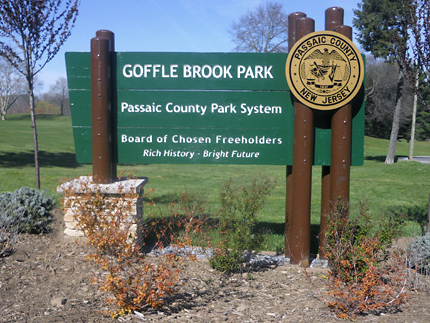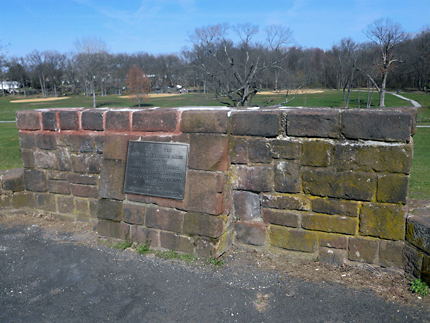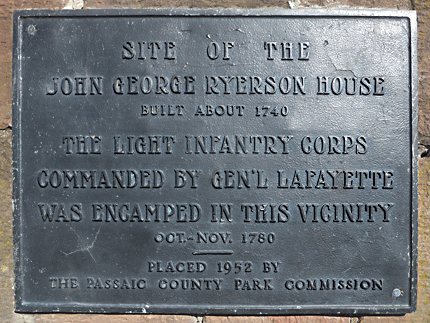


The original portion of the building, built circa 1730
Lafayette made his headquarters in a tent near the house in 1780.

Full building. The larger section on the left was added circa 1800
by
Richard Degray, years after the Revolutionary War ended in 1783
John Francis Ryerson House (Also known as the Degray House)
Now the Bottagra Restaurant
80 Wagaraw Rd
Map / Directions to the John Francis Ryerson House Site
Lafayette Encampment Site, October 9 - November 27, 1780 [1]
The oldest portion of what is now the Bottagra Restaurant was built circa 1740 by John Francis Ryerson. He was still living in the house at the beginning of the Revolutionary War. He remained Loyal to England in the war, and because of this had his property confiscated in 1779 after he had fled to Nova Scotia. The house would then go through a series of owners over the next two decades.
In July, October, and November 1780, there was a great deal of military activity in what is now Passaic County. While General George Washington made his headquarters at the Dey Mansion in Wayne, troops of the Continental (American) Army were spread out through the area that now makes up Totowa, Woodland Park, Little Falls, and Hawthorne. [2]
During October and November, General Lafayette and his light infantry troops were encamped in what was then called Wagaraw, and is now part of Hawthorne. The light infantry corps commanded by General Lafayette had been formed two months before. [3]
During the encampment, Lafayette made his headquarters in a tent outside of the John Francis Ryerson house. His light infantry troops were positioned in a line that cut diagonally through the center of town.
On October 23, Lafayette and his light infantry troops moved to Cranetown (now Montclair). Three days later, they marched from Cranetown to Elizabethtown (now Elizabeth), from where they planned to make an attack on British troops on Staten Island. The attack was never made because the boats they were supposed to use to cross the water over to Staten Island did not arrive. Lafayette and his troops marched back to their position at Cranetown on the 28th, where they remained until the next day when they returned to their camp here at Wagaraw/Hawthorne. [4] They remained here until November 27, when the entire Continental Army moved out of the area. On that same day, Lafayette's light infantry corps was dissolved. [5]
In 1800 the house was purchased by Richard Degray. He added the larger section on the left of the building. The house remained in the Degray family until the 20th Century. It is now referred to as both the John Francis Ryerson House and the Degray House. The building is currently used as the Bottagra Restaurant.





John George Ryerson House Site
Inside Goffle Brook Park
Goffle Rd. - Use park entrance near Macfarlan Ave.
Map / Directions to the John George Ryerson House Site
About a half-mile north of the John Francis Ryerson House described above, there is a plaque marking the site of the home of his cousin, John George Ryerson.
John George Ryerson did not remain loyal to England, and so, unlike his cousin, he continued to live in his house throughout the war. Later generations of his family remained in the house until the 20th Century.
The John George Ryerson House burned down in 1950. [6] The plaque in Goffle Brook Park which stands at the site of the house was erected in 1952. [7] The plaque also commemorates the encampment of Lafayette's troops in the area.
The main line of the encampment was actually positioned a short distance from the site of the plaque. The troops stretched along a line on the other side of the Goffle Brook, which runs through the middle of the park. That line ran diagonally through the modern Hawthorne streets which are now located next to the park, to the east and south. [8]
However, the troops must have walked over the entire area now making up the park many times during their encampment. Lafayette may have also visited the John George Ryerson House during this time. In fact, for many years it was mistakenly believed that Lafayette made his tent headquarters outside of the John George Ryerson House, rather than the John Francis Ryerson House.

1. ^ An invaluable source for the research for this pages was:
Walter Arndt Lucas, "Lafayette's Encampment at Wagaraw," Bulletin of the Passaic County Historical Society, Volume 3, No. 10, July 1951, Pages 54 - 60
Available as a PDF on the Lambert Castle website here (Note that although the article appears on the pages numbered 54-60 of the Newsletter, it appears on pages 14-20 of the PDF document.)
▸ Lucas's article is an excellent discussion of the location of Lafayette's encampment at Wagaraw/Hawthorn. Part of Lucas's objective was to clarify exactly where Lafayette had his tent, and he sets out to demonstrate that it was near the house of John Francis Ryerson, rather than near the house of John George Ryerson.
His article is well-written, well-researched, and well-documented with source notes.
To this writer, Lucas's case for locating Lafayette's tent near the John Francis Ryerson house seems conclusive. The article is highly recommended to those wishing to study the matter in more depth.▸ ▸ In the course of his article, Lucas mentions several other works, which were also consulted in the research for this page.
Links to three of these works appear below:• Marquis de Chastellux, Travels in North-America, in the Years 1780—81—82 (American Edition, reprinting the text of an edition translated into English and released in 1787) (New York, 1828) Pages 57 - 60
Available to be read at the Internet Archive here• William Nelson, "Washington's Headquarters at Preakness," The Magazine of American History with Notes and Queries, Volume 3
Available to be read at Google Books here• Roads from Pompton, Paramus, Great Falls +c (2nd part) No 56, B / Map by Robert Erskine F.R.S. Geogr. A. U.S. and Assistants.
Available at the Witness to the Early American Experience website here
Many of Lafayette's letters from October 9 - November 27 are available to be read at the National Archives / Founders Online website here
Most of these letters were marked by Lafayette as having been sent from the "Light Camp," but in several he is more specific and mentions that the Light Camp is in Totowa, and in two cases goes further to mention that the camp is on the Passaic River.
Note that Totowa at that time referred to a much larger area than the present day town of Totowa, and included parts of present-day Hawthorne and Paterson.
Note also that the Passaic River runs right along this area, and that the John Francis Ryerson House is less than 500 feet from the Passaic River
Three letters which include the designation of the camp being at Totowa are listed below:• “To Benjamin Franklin from the Marquis de Lafayette, 9 October 1780,” Founders Online, National Archives (http://founders.archives.gov/documents/Franklin/01-33-02-0336 [last update: 2016-03-28]). Source: The Papers of Benjamin Franklin, vol. 33, July 1 through November 15, 1780, ed. Barbara B. Oberg. New Haven and London: Yale University Press, 1997, pp. 395–396.
•“To George Washington from Major General Lafayette, 12 October 1780,” Founders Online, National Archives, https://founders.archives.gov/documents/Washington/03-28-02-0276. [Original source: The Papers of George Washington, Revolutionary War Series, vol. 28, 28 August–27 October 1780, ed. William M. Ferraro and Jeffrey L. Zvengrowski. Charlottesville: University of Virginia Press, 2020, pp. 523–525.]
• “To Benjamin Franklin from the Marquis de Lafayette, 19 November 1780,” Founders Online, National Archives (http://founders.archives.gov/documents/Franklin/01-34-02-0014 [last update: 2016-03-28]). Source: The Papers of Benjamin Franklin, vol. 34, November 16, 1780, through April 30, 1781, ed. Barbara B. Oberg. New Haven and London: Yale University Press, 1998, pp. 29–32.
A letter written by Lafayette to Vicomte de Noailles on October 23, 1780 is specifically marked as being sent from Wagaraw ("camp, Wagharough").
The letter, written in French, is available untranslated at the Bibliorare website here.2. ^ For more information, along with accompanying source notes, about General George Washington and the Continental Amy in the area in 1780, see the Wayne, Totowa, Woodland Park, and Little Falls pages of this website.
▸ Note that while all of these towns are now part of Passaic County, the area was then part of Bergen County.
Passaic County was not created until 1837, fifty-four years after the end of the Revolutionary War.
For more information, see:
John F. Snyder, The Story of New Jersey's Civil Boundaries: 1606-1968 (Trenton: Bureau of Geology and Topography, 1969) page 209
Available as a PDF on the State of New Jersey website here.
(Note that although the information is on the page numbered 201 of the document, it is on page 198 of the PDF file.)3. ^“General Orders, 1 August 1780,” Founders Online, National Archives, https://founders.archives.gov/documents/Washington/03-27-02-0334. [Original source: The Papers of George Washington, Revolutionary War Series, vol. 27, 5 July–27 August 1780, ed. Benjamin L. Huggins. Charlottesville: University of Virginia Press, 2019, pp. 384–387.]
4. ^ The following letters pertain to Lafayette's light infantry troops' time at Cranetown and their attempted attack on Staten Island. Please note that mentions of Totowa in these letters refer to Lafayette's encampment site in Wagaraw/Hawthorne. (Totowa in that era referred to a larger area than the modern-day borough of Totowa.)
“General Orders, 23 October 1780,” Founders Online, National Archives, https://founders.archives.gov/documents/Washington/03-28-02-0351. [Original source: The Papers of George Washington, Revolutionary War Seri
“From Alexander Hamilton to Colonel Timothy Pickering, [25 October 1780],” Founders Online, National Archives, last modified December 28, 2016, http://founders.archives.gov/documents/Hamilton/01-26-02-0002-0048. [Original source: The Papers of Alexander Hamilton, vol. 26, 1 May 1802 – 23 October 1804, Additional Documents 1774–1799, Addenda and Errata, ed. Harold C. Syrett. New York: Columbia University Press, 1979, pp. 402–403.]
“To George Washington from Major General Lafayette, 27 October 1780,” Founders Online, National Archives, https://founders.archives.gov/documents/Washington/03-28-02-0381. [Original source: The Papers of George Washington, Revolutionary War Series, vol. 28, 28 August–27 October 1780, ed. William M. Ferraro and Jeffrey L. Zvengrowski. Charlottesville: University of Virginia Press, 2020, pp. 658–660.]
“To George Washington from Major General Lafayette, 27 October 1780,” Founders Online, National Archives, https://founders.archives.gov/documents/Washington/03-28-02-0382. [Original source: The Papers of George Washington, Revolutionary War Series, vol. 28, 28 August–27 October 1780, ed. William M. Ferraro and Jeffrey L. Zvengrowski. Charlottesville: University of Virginia Press, 2020, pp. 660–662.]
“To George Washington from Major General Lafayette, 28 October 1780,” Founders Online, National Archives, https://founders.archives.gov/documents/Washington/03-29-02-0004. [Original source: The Papers of George Washington, Revolutionary War Series, vol. 29, 28 October–31 December 1780, ed. William M. Ferraro. Charlottesville: University of Virginia Press, 2021, pp. 5–7.]
5. ^“General Orders, 26 November 1780,” Founders Online, National Archives, https://founders.archives.gov/documents/Washington/03-29-02-0225. [Original source: The Papers of George Washington, Revolutionary War Series, vol. 29, 28 October–31 December 1780, ed. William M. Ferraro. Charlottesville: University of Virginia Press, 2021, pp. 343–345.]
6. ^ Walter Arndt Lucas, "Lafayette's Encampment at Wagaraw," Bulletin of the Passaic County Historical Society, Volume 3, No. 10, July 1951, Pages 55 (footnote 11), and 58
Available as a PDF on the Lambert Castle website here (Note that although the information appears on the page numbered 55 and 58 of the Newsletter, it appears on pages 15 and 18of the PDF document.)7. ^ Plaque placed by the Passaic County Park Commission in 1952.
8. ^ The positioning of the encampment is described in detail in Walter Arndt Lucas article "Lafayette's Encampment at Wagaraw," along with maps.
See Source Note #1 above for more information.